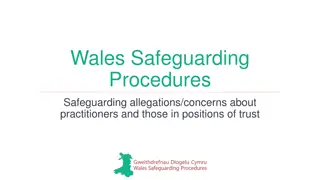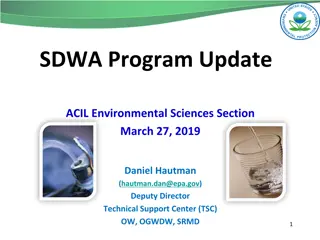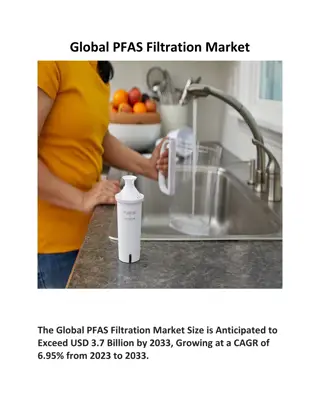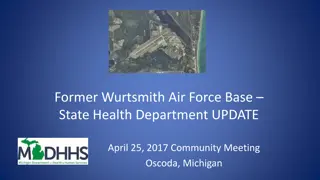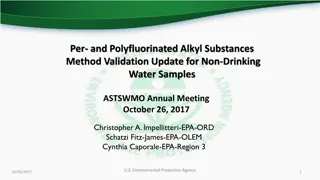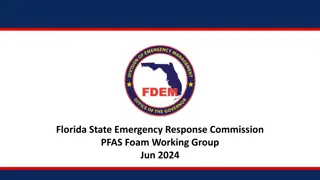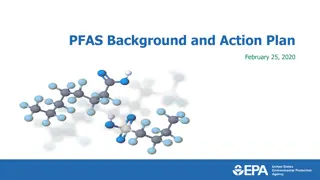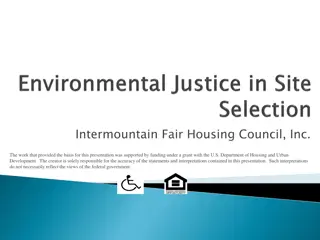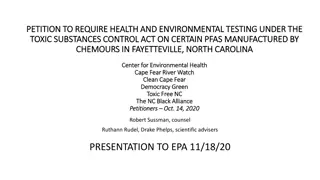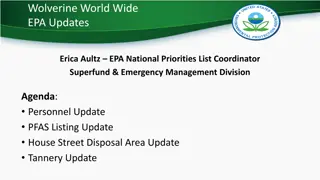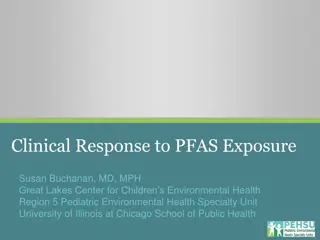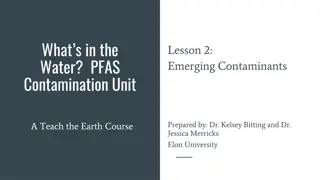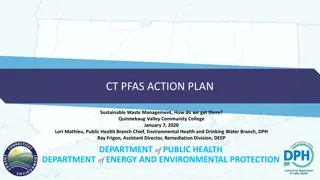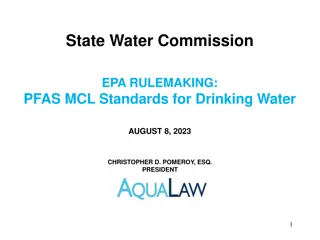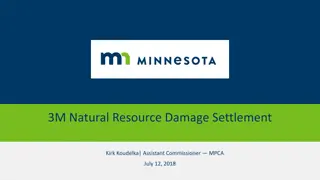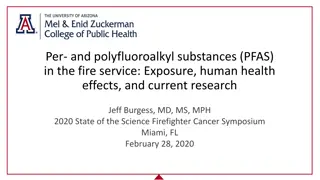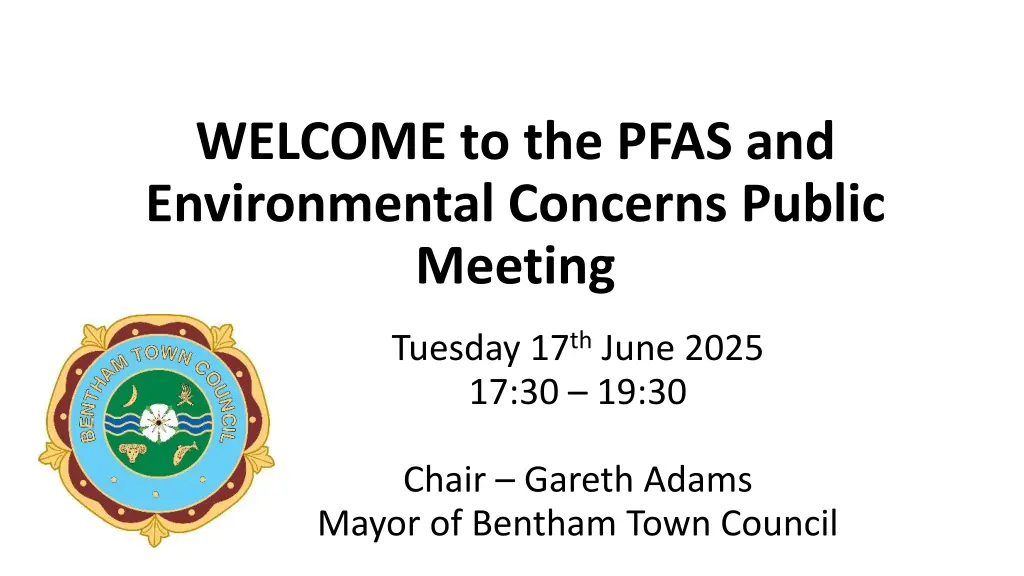
PFAS and Environmental Concerns Public Meeting
Join the PFAS and Environmental Concerns Public Meeting chaired by Gareth Adams, Mayor of Bentham Town Council. Learn about environmental issues, panel discussions, and public interactions with experts from various agencies.
Download Presentation

Please find below an Image/Link to download the presentation.
The content on the website is provided AS IS for your information and personal use only. It may not be sold, licensed, or shared on other websites without obtaining consent from the author. If you encounter any issues during the download, it is possible that the publisher has removed the file from their server.
You are allowed to download the files provided on this website for personal or commercial use, subject to the condition that they are used lawfully. All files are the property of their respective owners.
The content on the website is provided AS IS for your information and personal use only. It may not be sold, licensed, or shared on other websites without obtaining consent from the author.
E N D
Presentation Transcript
WELCOME to the PFAS and Environmental Concerns Public Meeting Tuesday 17thJune 2025 17:30 19:30 Chair Gareth Adams Mayor of Bentham Town Council
Event Information & Housekeeping Notes Event Information & Housekeeping Notes Restrooms Ladies toilets are located outside the ballroom. Gents and inclusive facilities can be found downstairs. Fire Safety In the event of a fire, please proceed calmly to the nearest exit, located at the rear or on either side of the stage. ?Assistance If you require assistance during evacuation, our staff are available to help. Filming in Progress Please note that filming and recording is currently taking place. If you do not wish to appear on camera, inform a member of staff. Respect & Conduct We ask all attendees to be respectful, courteous and attentive throughout the event. Disruptive or inappropriate behaviour will not be tolerated. Thank you for your cooperation.
Meeting Structure: Meeting Structure: Total Duration: Maximum of 2 hours Welcome and Introductions from Panellists Duration: 15 minutes Setting the Scene Remarks by Mayor Adams Background and purpose of the meeting Duration: 15 minutes Presentations by the Environment Agency, North Yorkshire Council and Yorkshire Water Duration: 30 minutes Panel Responses to Pre-Submitted Questions Duration: 45 minutes Open Public Comments and Questions Duration: 15 minutes *Timings are approximate
Panellists: Panellists: Environment Agency John Neville North Yorkshire Council Vikki Flowers Head of Environmental Protection Dr Kevin Carr Scientific Team Manager Callum McKeon Assistant Director of Regulatory & Harbour Services, Registration, Bereavement, Coroners Service Yorkshire Water Sarah Robinson Corporate affairs manager Luke Montgomery Head of Water Quality
Others in Attendance: Others in Attendance: North Yorkshire Councillor David Ireton North Yorkshire Council Dr Victoria Turner Public Health James Sherwood UK Health Security Agency Greg Hodgson - Regional Head, Environmental Hazards & Emergencies Dept (North) Amanda Craswell, Specialist Environmental Public Health Scientist (North Region) Dr Katie Comer, Consultant in Health Protection UKHSA Y&H Claire Roach Environment Agency Lisa Chadwick
Background and Purpose of the Meeting Background and Purpose of the Meeting Bentham Town Council were first made aware of the PFAS issue when the Guardian Article was initially published; on the 25th May 2024 On publication, the Council encountered a steep learning curve to not only digest the report, but also furnish ourselves with as much knowledge as we could. We subscribed to the ENDS report, to obtain the full report. The Council were invited to meet with Angus Fire on the 30th May 2024, where Angus Fire were able to discuss the article and explain the details contained within the report. The Town Council meeting took place on the 3rd June 2024.
Background and Purpose of the Meeting Background and Purpose of the Meeting From this meeting Angus informed the Council of their forward strategy. This included appointing consultants to assist them and progressing a number of surveys to better understand the extent of condition. The Council requested that some additional areas were included in the survey such as the playing fields and areas near to Duke Street. These were agreed to by Angus Fire and subsequently included in the scope. Following the results from these Surveys Angus invited us back on the 17th September. They shared the results and their progress to date as well as their next steps.
Background and Purpose of the Meeting Background and Purpose of the Meeting A further meeting was held on the 16th December, again where updates were shared. The Council was invited back on the 25th March to see the installation of the storm water treatment plant, which at this time was close to the end of its commissioning phase. This plant awaits EA permission for use. Angus fire has continued to provide up to date statements direct to Council, which have been read out in full and appended to the meeting minutes. In addition, these have been published on the Angus Fire micro site at www.derbs.co.uk
Background and Purpose of the Meeting Background and Purpose of the Meeting The Council had contacted Yorkshire water prior to the June 2024 Town Council Meeting. The following response was received: Thankyou for your query regarding the standards / safety of the water throughout Yorkshire. To make sure the water we supply your home meets the government's high standards, we regularly take samples from our treatment works, service reservoirs and customers' taps for testing. We test over 500,000 water samples every year! We also carry out operational checks, using state-of-the-art technology and laboratory techniques, to make sure your water is the best possible quality. The Drinking Water Inspectorate (DWI) then looks at the results from these tests and creates an independent report on its findings. In terms of PFAS specifically, there are currently no statutory standards for PFAS in drinking water in England and Wales, nor is there a World Health Organisation guideline value. In spite of this, PFAS is one of many components we do vigorously test for. In terms of reactive measures, we do home water quality inspections. These are spot checks and we randomly select addresses from each of our supply zones. We also come out to test the water as quickly as possible upon consumer request where one may be concerned with the quality of the water we are providing.
Background and Purpose of the Meeting Background and Purpose of the Meeting At the December 2024 Town Council meeting, discussions at the meeting led to the Council requesting the Environment Agency to share with the Town Council their perspective to date. This led to a meeting that was held on the 7th April 2025 at Skipton, where the Environment Agency, NYC, Health Standards Agency, Angus Fire, Bentham Town Council and our NYC Councillor met. This meeting brought everyone up to date with where our various regulatory bodies currently stood. It was suggested by Bentham Town Council that a public meeting should be held so that these positions could be shared amongst the community.
Background and Purpose of the Meeting Background and Purpose of the Meeting Those Councillors at the meeting felt that it was a positive meeting. We suggested the format for the meeting and notice was duly given to allow members of our community to submit questions for response. The council felt that by doing this, it would allow responses to be formulated, so they could be answered. The purpose of tonight is to allow our statutory bodies to inform the public of Bentham on the current position, to receive the responses to the questions already posed and to ask any follow up questions.
Background and Purpose of the Meeting Background and Purpose of the Meeting In addition to the Angus Fire updates, the Council has received letters and enquiries from members of our community, including: Interested parties at our monthly Town Council meetings. Updates from Cleaner Bentham. Freedom of information requests from various sources. This will be the first in a series of public meetings, communications and drop-in sessions involving regulators and government organisations concerned with PFAS and environmental issues in the Bentham area.
Public Meeting Public Meeting Bentham, Yorkshire Bentham, Yorkshire
History Angus Fire manufacture Aqueous Film Forming Foams (AFFF) at their site in High Bentham, North Yorkshire. It is the production of AFFF that required the use of PFAS. Angus Fire, due to its historic use of PFAS, is a source of PFAS into the environment. We have gathered evidence which shows PFAS within the groundwater below the site and the ground on the site. We are taking steps to: understand the potential impact, review compliance with the Environmental Permit and the site s activities, consider any remediation requirements consider if any appropriate regulatory and enforcement steps are needed to protect people and the environment 14
Current Activity As a result of collecting information, we are in a place where we need to better understand what the impacts of some of those reports and if they point to more significant breaches of the permit. The permit is currently under review We have to be mindful that in looking at potential permit breaches and causes of any release into the environment we can't always share all information. 15
Enforcement/Investigation There is no specific timeframe for this the causes are currently being looked in to alongside the potential impacts and actions the company may need to take. In terms of PFOA and PFAS work is ongoing There is likely to be more investigation required 16
Next Steps EA Specific To look at actions and measures needed to protect the environment moving forward. To hold the operator to account for any impacts on the environment from their operation Multi Agency To work with partner organisations to assess and better understand any developing risks Communication Share as much information as we have on the site and actions initially via the Town Council, with a view to a more dedicated portal/site that anyone can access Arrange public information sessions moving forward 18
Contaminated Land Regulation Part IIA Environmental Protection Act 1990 Dr Kevin Carr Scientific Team Manager
Definition Section 78A(2): contaminated land is any land which appears to the local authority in whose area it is situated to be in such a condition, by reason of substances in, on or under the land that (a) significant harm is being caused or there is a significant possibility of such harm being caused; or (b) significant pollution of controlled waters is being caused, or there is a significant possibility of such pollution being caused
Risk Assessment Contaminant How toxic is the substance (toxicological data)? Pathway How a contaminant reaches a receptor Receptor Person / Controlled Waters Risk the likelihood that a receptor will be exposed to a contaminant in such a way and in sufficient concentrations to pose a significant possibility of significant harm.
Harmful Concentrations (PFAS) Lack of toxicological data for PFAS: No acceptable limits for soils etc. What level is safe? Regulators need more information to establish whether land is contaminated and what concentration to remediate it to.
Next Steps Await development of legal soil concentration limits for PFAS. Category 4 Screening Levels (C4SL) only available for 4 PFAS (PFOA, PFOS, PFHxS and PFNA). Uses a Hazard Index Approach - recommends further study over certain levels. Work with Angus Fire to further understand sources and pathways for PFAS. Work with Angus Fire and their consultants to review previous investigations and advise on future study. Continue to liaise with Environment Agency and UK HSA.
Private Water Supplies Vikki Flowers Head of Environmental Protection
Private Water Supplies Private water supply not mains water and not provided by a water company. Borehole, spring, wells, streams. Supplies are owned by a relevant person - individuals, companies, collectives. Local authorities are responsible for enforcing the standards of private water supplies as set out in the: Water Industry Act 1991 Private Water Supplies (England) Regulations 2016 Regulated by the Drinking Water Inspectorate (DWI) This is done by a regime of risk assessments and sampling (examination and analysis). The Council can take enforcement action if supplies are found to be non-compliant with the Regulations however in most circumstances supply owners will be given time to make the necessary improvements.
Private Water Supplies In 2007 the Drinking Water Inspectorate (DWI) first provided PFAS guidance to water companies and local authorities responsible for private water supplies. In 2021 updated guidance recommended a value of 0.1 micrograms per litre ( g/L) for PFAS for all drinking water. Water companies and private water supplies assessed to have potential PFAS contamination are required to be monitor for 48 individual PFAS chemicals. Where the sum of all the 48 PFAS chemicals assessed is greater than 0.1 micrograms this must be reported to the DWI as a water quality event and all necessary actions to reduce concentrations below this value must be taken. The 0.1 micrograms per litre ( g/L) level is currently assessed (DWI) to be robust with an appropriate margin to ensure drinking water is safe. Due to the wide range of PFAS sources entering the environment, and the persistence of the substances, the DWI recommended that local authorities assess the potential for the presence of PFAS when conducting risk assessments of private water supplies.
Private Water Supplies In 2007 the Drinking Water Inspectorate (DWI) first provided PFAS guidance to water companies and local authorities responsible for private water supplies. In 2021 updated guidance recommended a value of 0.1 micrograms per litre ( g/L) for PFAS for all drinking water. Water companies and private water supplies assessed to have potential PFAS contamination are required to be monitor for 48 individual PFAS chemicals. Where the sum of all the 48 PFAS chemicals assessed is greater than 0.1 micrograms this must be reported to the DWI as a water quality event and all necessary actions to reduce concentrations below this value must be taken. The 0.1 micrograms per litre ( g/L) level is currently assessed (DWI) to be robust with an appropriate margin to ensure drinking water is safe. Due to the wide range of PFAS sources entering the environment, and the persistence of the substances, the DWI recommended that local authorities assess the potential for the presence of PFAS when conducting risk assessments of private water supplies.
Private Water Supplies In 2024 NYC instigated a PFAS monitoring program for the Private Water Supplies at Riverside Caravan Park and Bentham Golf Club. Regular sampling is being undertaken - three times a year. The sampling and analysis is carried out by an approved and accredited laboratory and results have clearly and consistently demonstrated that PFAS is not present in either supply. The total concentration for the 48 PFAS chemicals has been repeatedly reported as zero. NYC will continue to monitor the PWS at Riverside Caravan Park and Bentham Golf Club for PFAS as a precaution. There are no other PWS within a 5km of Angus Fire (as far as the Council knows following research).
Yorkshire Water Yorkshire Water
Statements received from Statements received from United Utilities We are sorry that we are unable to attend your meeting this evening. Unfortunately, the people from United Utilities best placed to join you are unavailable tonight so thank you for the opportunity to provide a statement and sharing it in the meeting. We hold the same view as everyone in the room that we want to see improvements in river water quality. We know how important that is to local people who treasure their waterways, whether that is because they use the water, walk by it, or take great pleasure from how nature thrives around good quality waterbodies. Last year, we completed a half million-pound project at Low Bentham wastewater treatment works to install new treatment and increase storage to reduce spills into the river Wenning. We similarly introduced additional storage and treatment at Wray. These are already making a difference.
We have now started to deliver our latest five-year business plan which runs from 2025 to 2030. We are embarking on an historic level of investment which we will see us protect and enhance over 500 kilometres of rivers across the North West and reduce spills from storms overflows over the decade to 2030 by 60%. In the River Wenning catchment, we are spending around 27 million across several projects at our wastewater treatment works to increase the amount of water we can store when it rains heavily, so reducing the number of spills into the Wenning and improving its water quality. The details are as follows: At High Bentham wastewater treatment works, we are building two new storage tanks. Their size will take into account planned development in the local catchment. At Low Bentham and Wray wastewater treatment works, we will further increase storage to reduce spills, building on the work recently undertaken.
We hope this offers reassurance that we are taking action to protect water quality in the River Wenning by reducing the frequency of spills from storm overflows. When it comes to PFAS, our wastewater treatment works receive PFAS through domestic sewage, trade effluent from industrial processes and from materials containing PFAS such as surface water run-off and tankered waste. Our treatment works have not been designed to remove PFAS and currently there is no effective technological solution for PFAS removal from wastewater. There is a current lack of regulation or guidance for PFAS in wastewater, trade effluent and tankered waste and no consistent standard for detecting and measuring PFAS. PFOS is the only member of the PFAS family that has an Environmental Quality Standard (EQS) set under the Water Framework Directive Regulations. This is a set concentration in water bodies to protect human and environmental health.
Over the last decade, we have been sampling a selection of our sites to understand the concentrations of PFOS in the effluent. This will continue as part of an expanded sampling programme under the Water Industry National Environment Programme with the expectation there will be no deterioration from the current baseline at these selected sites. This will include sampling in the sewer network to understand inputs from industrial use and from contaminated surface water to help identify how we can reduce concentrations entering our sewerage network. We are collaborating with partners to bring about research into technologies and guidance to treat at source. We support the implementation of science based environmental water quality standards for PFAS through the polluter pays principle. Extra costs should not be borne by water companies and their customers. Through the sector s Chemicals Investigation Programme (CIP4), we will take part in research to build further knowledge and understanding of PFAS at wastewater treatment works. Tackling PFAS is an emerging concern and we understand why people are keen to know more. At United Utilities, we are working hard to improve our understanding and to engage with policy makers so that the right interventions can be found to tackle this important issue.
Pre Pre- -submitted Questions submitted Questions
Follow up Questions Follow up Questions Opportunity for open questions to be asked. Please be aware that the answer may not be immediately available. In such cases, we will ensure the question is noted and a response provided at a later time. In some circumstances it may not be possible to answer the question. We have a roving microphone, please wait for it to arrive so everyone can hear your question. We will take questions in turn from different members of the community, to give as many different people the chance to ask their question.
PFAS and Environmental Concerns Public Meeting Tuesday 17th June 2025 17:30 19:30 Thank you for your attendance.



